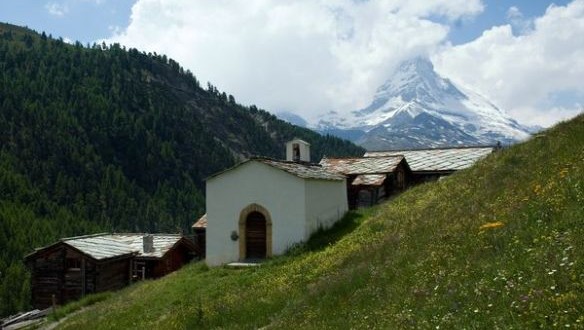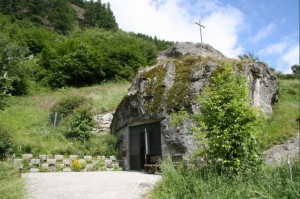Findeln chapel or Jakobus der Altere is the chapel in Findeln and is dedicated to St.James, patron saint of pilgrims, and belongs to Zermatt’s older sanctuaries. The winged altarpiece is a piece of cultural heritage unmatched in the Upper Valais. Findeln, probably the sunniest hamlet in the vicinity of Zermatt, must have had a chapel from early on. It stands at an altitude of about 2100 meters. The documented filed name of “zer altu Kapallu” a little further up the slope indicates that this was the case. In the days when agriculture was still the main source of income, the inhabitants of Zermatt would make a pilgrimage to Findeln after long periods of rain during the hay harvesting season to pray for sunshine, the last time being in 1954. Today’s chapel in the lower part of Findeln, “ze Gasse”, was built in either 1691 or 1697, the latter year is inscribed on the tuff arch that frames the entrance doors, as a simple block structure with a recessed choir. It is dedicated to St.James the Elder. It first appears in records as a simple prayer house without an altar. During the visitation by the bishop in 1765, the order was given to renovate the prayer house, which had been almost totally destroyed by an earthquake, and to equip it with suitable altar. The baroque style conquered the Upper Valais in the 17th century, transforming the appearance of churches and chapels. The parish church, too, had to remove Gothic features. In 1772, presumably the parish church’s altar to the Mother of God came to Findeln. This late-Gothic winged altarpiece from the beginning of the 16th century is a piece of artistic history unique in the Upper Valais. As a result, the chapel is listed in the Swiss Inventory of Cultural Property of Regional Significance.
Fuxstein chapel is a beautiful chapel that you have to visit. With unusual sanctuary, this chapel is hollowed out of a boulder that stands on the valley floor allowing the visitors to have a special experience. The famous Fuxstein rock lies near Schopf, surrounded by meadows and pastures. Inside is a small shrine that attracts many pilgrims. People taking a Sunday stroll often like to walk here. The peaceful setting is ideal for anyone wishing to offer a quiet prayer and lay their problems before Our Lady of Sorrows. The existing Fuxstein chapel was extended several times being fully renovated which now incorporates a sanctuary. 449 explosive charges were needed to hollow out the space for the new “Seiben Schmerzen Mariens” chapel. The Marian year of 1954 and a personal request from the parish priest made it possible to enlarge and redesign the chapel. In 1977, the chapel received a different altarpiece depicting the “Sieben Schmerzen Mariens”, the Seven Sorrows of Mary, obtained from the White Fathers in Luceme. This purchase became necessary after the two most beautiful statues were stolen. Another renovation took place in 1997. The interior, walls and floor were renewed, a restored altar was installed and a new terrace was laid out in front of the chapel. The young people of the village planted a tree.


